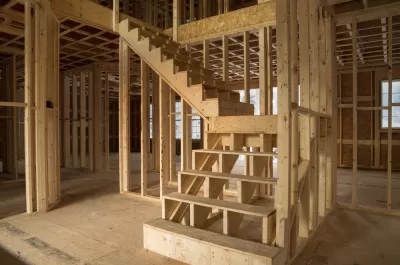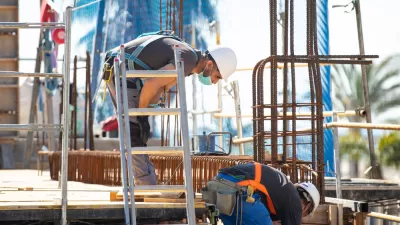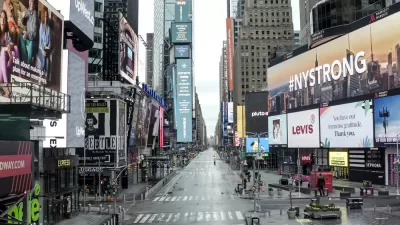After a 22% drop in housing starts in March, municipalities and state governments continue to assess whether or not housing construction is essential, weighing factors like workforce safety and availability of construction materials.

In a Joint Center for Housing Studies of Harvard University blog post, Whitney Airgood-Obrycki identifies four reasons that construction projects could be delayed as a result of the coronavirus pandemic. "COVID-19 will have many effects on housing markets in the coming weeks and years. One of the near-term consequences of the spread of and response to the virus is likely to be delayed construction due to office closures, construction moratoria, supply chain disruptions, and risks to the labor force," writes Airgood-Obrycki.
Closures of city offices and remote work means impeded permitting, inspection, and review. According to a survey by the National Association of Home Builders, 90% of participants reported an increase in the time required to obtain a plan review. Of the same group, 76% experienced delays in inspections.
As of Airgood-Obrycki's writing, construction bans were in place in six states (Michigan, New Jersey, New York, Pennsylvania, Vermont, and Washington) in addition to many cities. New York and New Jersey are allowing construction on affordable housing projects. Difficulties in sourcing materials due to disruption in the global construction material supply chain leaves many projects at a standstill. Concerns about keeping construction workers safe on-site include a lack of access to sanitization products and a shortage of N-95 masks that protect workers from particulate matter. Retention in the construction labor force will depend heavily on the ability of project managers to protect staff where work is available.
FULL STORY: COVID-19 WILL DELAY HOUSING CONSTRUCTION, BUT FOR HOW LONG?

Study: Maui’s Plan to Convert Vacation Rentals to Long-Term Housing Could Cause Nearly $1 Billion Economic Loss
The plan would reduce visitor accommodation by 25,% resulting in 1,900 jobs lost.

North Texas Transit Leaders Tout Benefits of TOD for Growing Region
At a summit focused on transit-oriented development, policymakers discussed how North Texas’ expanded light rail system can serve as a tool for economic growth.

Using Old Oil and Gas Wells for Green Energy Storage
Penn State researchers have found that repurposing abandoned oil and gas wells for geothermal-assisted compressed-air energy storage can boost efficiency, reduce environmental risks, and support clean energy and job transitions.

From Blight to Benefit: Early Results From California’s Equitable Cleanup Program
The Equitable Community Revitalization Grant (ECRG) program is reshaping brownfield redevelopment by prioritizing projects in low-income and environmental justice communities, emphasizing equity, transparency, and community benefits.

Planting Relief: Tackling Las Vegas Heat One Tree at a Time
Nevada Plants, a Las Vegas-based nonprofit, is combating the city’s extreme urban heat by giving away trees to residents in underserved neighborhoods, promoting shade, sustainability, and community health.

How Madison’s Tree Planting Efforts Are Growing a Healthier Community
Madison’s annual tree planting initiative is enhancing environmental resilience, public health, and community livability by adding 1,400 carefully selected trees citywide, with strong community and institutional support for urban forestry.
Urban Design for Planners 1: Software Tools
This six-course series explores essential urban design concepts using open source software and equips planners with the tools they need to participate fully in the urban design process.
Planning for Universal Design
Learn the tools for implementing Universal Design in planning regulations.
Ascent Environmental
Borough of Carlisle
Institute for Housing and Urban Development Studies (IHS)
City of Grandview
Harvard GSD Executive Education
Toledo-Lucas County Plan Commissions
Salt Lake City
NYU Wagner Graduate School of Public Service





























